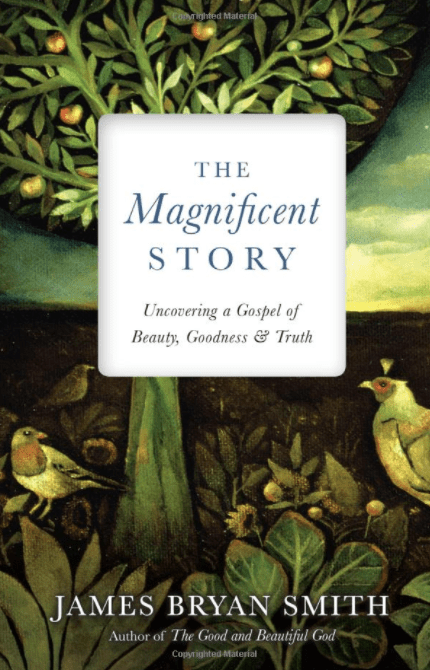 James Bryan Smith, in his wonderful new The Magnificent Story: Uncovering a Gospel of Beauty, Goodness and Truth, contends there are some very common narratives that are both false narratives and damaging to the Christian’s understanding of God.
James Bryan Smith, in his wonderful new The Magnificent Story: Uncovering a Gospel of Beauty, Goodness and Truth, contends there are some very common narratives that are both false narratives and damaging to the Christian’s understanding of God.
Smith’s work is about the only discipleship book for church folks that is rooted in the Bible’s overarching narrative itself. It is also designed on the basis of experience for lay folks.
A must-have for churches.
There are two major false narratives that we seek to inhabit and both are less than satisfying; neither is magnificent — neither is beautiful, good and true.
False Narrative One
‘So,” my friend Jeff asked, “what is the point of Christianity? “It is trying to be a good person and to do good things. Trying to live an ethical life, to right society’s wrongs, and to engage in social justice causes,” the minister said. … The story I heard from my minister can be summed up like this: God is distant and uninvolved, so it’s up to us make the world better.
Dallas Willard called this “the gospel on the left.” It is most common in churches that are labeled “liberal.” People are attracted to these churches because of their emphasis on reason and social justice. Jesus becomes a compelling figure because he taught about love and kindness, about justice and mercy for the least and the lost, and ultimately gave his own life for this cause. Jesus’ miracles cannot be taken as literal, but must be seen as symbolic.
After hearing this gospel, Smith moved into the faith and then encountered another gospel narrative.
False Narrative Two
I was growing in my faith day by day, and Jesus was very real to me. Then I met a guy—I will call him Fred—who worked for a parachurch ministry for college students. He was not a student but was on campus to minister to them. When he found out I was a new Christian he decided to find out if I had come to saving faith (his term) in the right way. Over coffee he asked if I had prayed the “sinners prayer.” I told him I hadn’t. I didn’t even know what it was. If I had not done so I was not saved, he said. I asked what he meant by “saved.” He told me that salvation was the promise of eternal life in heaven when I died and that I could not be saved unless I prayed the right prayer, the right way. …
Then one day I came to the realization I hated being a Christian. I no longer wanted to be in the story. I told God I was leaving the ministry. I felt I would be happier as anything other than a minister. I gave Jesus one last season in my life to make a change. Jesus took me up on the offer. As he had done before, things started to change immediately. God used people and wonderful books to tell me something I never thought I would hear: being a Christian was not my problem. The problem was the story, Fred’s story. It was neither good nor beautiful nor true.
The gospel of Fred can be summed up like this: you are bad, God is mad, but Jesus took your beating. So try harder and you might make it to heaven.
These narratives don’t work because they are inadequate to the Subject– God.
If it is not true, it will be neither good nor beautiful, because you cannot have one without the other. Goodness is that which is beneficial. When you encounter goodness, the response is gratitude, a deep sense of thanksgiving. Both gospels contain a measure of goodness.The social gospel is about making the world better, which is good. But it’s up to us to make it happen. And that is not good. The shaming gospel is about Jesus dying for us, which is good. But it leaves an angry Father, who is still mad at us, and does not mention the work of the Holy Spirit. And that is not good. Neither story is truly and deeply good. At best they incite fear and servitude. Finally, neither story is beautiful, inspiring awe and wonder.
Neither is the story of the early Christians.
Neither leads us to love God, ourselves, and others with our entire heart, soul, mind, and strength (the Great Commandment).
Neither starts in the right place.
Neither includes the Trinity as one in heart and mission.
Neither views creation as a portal to God.
Neither sees Jesus in his complete form.
Neither leads naturally to discipleship.
But there is a gospel that is magnificent — beautiful, good and true.
There is good news: it’s a magnificent story that can woo us, wow us, humble us, and inspire us to love God, ourselves, and others. It is an ancient story. I will tell it the best I can in the following chapters. It is a story about the Trinity as a loving community, about creation as a proclamation of the glory of God and a sign of God s love, about humans bearing the image of God whose likeness has been tarnished by sin but designed for goodness and relationship with God, about the incarnation as the coming of a King and his unshakable kingdom, about a divine rescue mission, and finally about the restoration of all things. It is the story we all long for, the story we were meant to enter.












